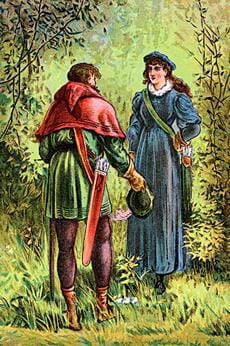Was Robin Hood Jewish?
I began researching this week's newsletter with a simple question: did Robin Hood wear a red hat? It led me down an existential rabbit-hole, and led to a conclusion which posed a completely different, albeit outlandish and preposterous, question.

The Jewish thing to do is to answer a question with another question.
Did Robin Hood really exist?
Was he Robert Heude from 1194 or the Earl of Huntington who died in 1284? Or Robyne Hude of 1283? Or related to Simon de Monfort and a massacre of Jews around 1265? Or Robbin Hood from 1198?
Instead of trying to focus on any one theory of the a "real" Robin Hood, note that all these characters fall into a roughly 100 year range from 1194 to 1290. We'll later see the significance of this particular time period.
Is "Robin" a Color?
What led me down the rabbit-hole was trying to understand the name "Robin Hood", which meant that I needed to research perceptions of the medieval "Robin".
Robin as a Name
Robin is a diminutive name for Robert, which is innocuous on its own.
Some French-English dictionaries would explain that Robin was a commonplace or placeholder name. One example was that the French version of Jack and [J]ill was Robin and Marion.
In A Little Sooth Sermon from 13th century collection of English poems, we see the name Robin used as a corrupter of fine young woman.
Robin wishes to lead Giloth to the alehouse,
And they sit together and spin their tales.
He may pay for her ale and later play that game;
To go with him at night she thinks it no shame.
Her father and her mother threaten to beat her;
She won’t give up Robin for all their threats.
Always will she claim no man came near her,
Until it happens that her womb rises up high.
– Translation to Modern English from Metis
Robin as a Red Bird
Many folk tales include a color in the name of the protagonist (eg. the Green Knight), a trend that has followed to the naming of superheroes. It just makes sense to me to have a color word (Robin) and a colorable identifier or descriptor (hood). And Batman’s sidekick Robin, who is dressed in a Lincoln Green and red outfit, as well.
Without thinking about it twice, I had considered robin to be a color word, because there is bird called the robin, who happens to be a red bird. As we saw with turkey, it is completely understandable to name a bird after a precious stone of the same color.
There is just one small flaw in my logic. The bird we refer to as the “robin” was in fact referred to by every single dictionary, poem, and book as the “robin red-breast”. This was unique to English. This is like calling someone a red-haired ginger, or in a word, redundant.
The robin red-breast, in one 16th century source I discovered, is referred to as “the little king”.
The little king or king of [birds] is naturally [very] small, of a [dainty] tractable complexion, he [sings] most sweetly, and is not much inferior in this respect unto the nightingale.
For which cause you shall put him in a cage, which hath some pretty provision made in manner of a little/chamber trimmed up with red cloth, and made as it were a little hothouse, whereinto he may withdraw himself in the night season and shun the cold all the whole year.
and sometimes you shall giue him of the paste that is used to be given to nightingales, which will do him no small good.
A sort of love poem insinuates that he doesn’t have the same talent or skill as the nightingale, but he still sings.
And then in an Italian-English dictionary, I discovered a random nugget which insinuated that the robin red-breast attempts to do battle against larger birds like the eagle:
Grimpereau, a little bird making [war] against the [Eagle], as Robin red-[breast], some do call that [bird] a nut [jobber]:
Grimpure, or grimpenient, ramping or grasping.
While I don’t know which robin red-breast had annoyed the writer of that entry, it did raise the question, what if the “robin” part of his name did not actually refer to a color word? Who is the Eagle and who is the Robin?
Robin as a Red Devil
There was another contemporaneous folk tale in England that had the name Robin. Robin Goodfellowe was the name for a red goblin or demon, like a hobgoblin.
He was sarcastically called “Good-fellow” in order to placate him, because I’m assuming that like the green Hulk, you really wouldn’t like him when he was angry.
When you look for the earliest usage of the phrase “round robin”, the Oxford English Dictionary refers to an English translation of Calvin writing about the Catholic sacrament, and noting that people callously called it a “jake [sic] in the box” and a “round robin”. The editors of the OED figured that the cracker was round and robin just seems to rhyme with that.
But I believe that it goes deeper than that. Robin was a nice name for the devil, or at least some sort of devilish imp. I think that “round robin” was a cute name to insinuate that the Catholics weren’t eating the body of Christ, but of the Devil.
Some Devilish Robins
- There was a French story about the son of the devil, Robert le Diable. In one of the English translations, it was translated to “Robin the Devil”.
- In the 1600 French version of the Dutch anti-Catholic Philip of Marnix’s book against the Church, he refers, repeatedly and solely, to Cardinal Roberto Bellamarino, as “Robin”. Bellamarino is best remembered for his role in the inquisition and execution of the heretic, poet, philosopher and cosmologist Giordano Bruno.
Was it because of his lovely red vestments, or because Marnix viewed Bellamarino with scorn as a little devil? I’m going to assume the latter. Reading this make me wonder, in how many other cases was Robin used as a diminutive for Robert, not as a sweet nickname, but as a term of derision? - There was Sir Robert Umfrevile, an entrepreneuring vice admiral of England who “annoyed the countries on the sea [coasts] of Scotland” by bringing ten ships of war in their harbor, taking spoils and prisoners and burnt down a Scottish ship, and was given the name of "Robin Mend-market". He subsequently took his fourteen year old nephew Gilbert on a trip to burn “Jedworth, and the most part of Tyusdale”.
- There was a supposed "witch" named Alice Kettle who was
charged to have [nightly] conference with a spirit called Robin Artisson, to whom she sacrificed in the high [way] nine red cocks, and nine peacocks [eyes].
Devilishly Red & Green
Between Robin Goodfellowe and Robert le Diable, the devil began to be portrayed as the color red. Was it because the association with the color word of robin? Even if it wasn’t the primary meaning, it still was subtly in the minds of the speakers.
For example, take this 19th century depiction of Robin Hood, wearing Lincoln green and a red hood.

But is wasn’t only the 19th century. There is a plant referred to as the Wake-Robin which according to Rembert Dodoens' Historie of Plants (1586), writes about a plant called a “dragon”, which like the Wake Robin is of a “greenish color without and of a darke red or purple color within”.
Robin as a Robber
As the title of 1991 movie says, Robin Hood is the Prince of Thieves. But then I saw something even more curious. One source even suggested that the etymology of "Roberdsmen" was because of Robin Hood’s men. Which is weird because robber actually comes from the robbare or robere.
For certainely, before nor since,
No man ere understood,
Under the reigne of any prince,
Of one like Robbin Hood.
Full thirteene yeares, and something more,
These outlawes lived thus,
Feared of the rich, loved of the poore,
A thing most marvelous.
Bad Robins
We always refer to “Robin Hood and his Merry Men”. While there have been attempts at revisionist history to question why and how the men were so merry and gay, the existence of Robin Good-fellow brings that into question. Could his merry men be referential to “good fellows”?
It seems like there are two distinct divergent paths between Robin Hood and his Merry Men and Robin Goodfellow: The former is personified by “robbing from the rich and giving to the poor”, basically financial crime, and the latter is associated with being the devil and blood worship. The only commonality between them is that they are both bad (to the authorities, at least).
Rabin as Demon
What makes the overall question most plausible is the problem that with the word "robin", namely, why is it so bad? How did "robin" receive all these negative attributes.
The answer may be simple. Robin is nearly homonymous to the word rabin.
While in modern English the word is rabbi, in many other languages, the word is Rabin. So, for example, the 1580 French volume by Jean Bodin about the “demon-mania of sorcerers”, which listed texts by Rabin Moyse (Maimonides) about the importance of blood in worship, is happening at the same time people are being accused of witchcraft in England.
Is it possible that a people who was literally demonized by the crown was not, in fact, hated by the populace, and that somehow, throughout anonymized and sterilized folklore, kept that alive in the English consciousness?
Overview of Negative Connotations
Robin Hood
There is a lot of debate about the origins of Robin Hood.
Time Frame (1194-1290)
In different versions, Robin Hood is connected with kings from King Richard I (Richard the Lionheart) when he returned from his Crusade in 1194, and was held for ransom, through King Edward I circa 1290.
Accusations
- Against the rich, for the poor.
- Against the church.
As the scholarly introduction to a modern edition of Martin Parker's 1631 "A True Tale of Robin Hood" includes:
Robin is worth discussing because he was a man of fame (line 10), generous and brave, fiercely anti-clerical -- castrating monks and friars was a normal practice of these sparkes (lines 65-72). He only shed blood in self defence, and mostly that of the crewell clergie (line 274).
Aftermath
His followers, when he was dead,
Were some received to grace;
The rest to forraigne countries fled,
And left their native place.
Robin Red-Breast
- Slightly Inferior bird
- Associated with swindling
- Dietary restrictions
Robin Goodfellow
- Devil
- Blood sacrifices
- Murder / mayhem
So, nu, was Robin Hood Jewish?
I feel like I may have oversold the preposterous nature of this claim.
At the very least, Mel Brooks made Robin Hood Jewish with Robin Hood: Men in Tights (1993), but it's more than that.
Timing
The earliest that Robin Hood was said to exist was in 1194, which seemed like a very specific date that carried a second connotation to me. It was the year that the Ordinance of the Jews was in England was entered into law. The Jews had been liable to raise more than the rest of the City of London put together to raise the ransom for King Richard I (Richard the Lionheart).
The period of 1194 - 1290 in England, can be described as a time that things went from bad to worse for the Jews of England, and after 1290, there were no Jews left in England, as they were all expelled.
Blood x Money
Upon his return, the ordinances began to limit the Jewish ability to lend money or collect on loans. Over the next century, blood libels and expulsions became commonplace throughout England. Blood libels were cases where Jews were accused of murdering gentile children and using their blood for religious or demonic purposes.
In 1253, the Statute of Jewry was declared by King Henry III, forcing Jews to wear badges and forbidden them to build synagogues, among other things. After nearly four more decades of increased antisemitism and increased taxes, reduced rights and abilities, accusations of witchcraft and blood ceremonies, and imprisonments and executions, in 1290, Jews were expelled for good from England with the Edict of Expulsion by King Edward I.
Some Jews had converted to Christianity instead.
It was only in 1656 that Jews were finally allowed to live in London again. The first Jews who had been from Converso families expelled from Portugal, who had moved to Amsterdam, and moved to London as Christians, until Rabbi Menasseh ben Israel appealed to Oliver Cromwell, who acceded to allow them to live openly as Jews.
A Second Class Bird?
Does this all mean that the Robin Red-Breast is somehow a metaphor for the second class nature of the Jews of England, who weren’t quite as good as singing as the nightingale, and couldn’t always eat everything the nightingale could eat? The note about dietary restrictions is just odd, unless it's a metaphor for something else.
How likely is any of this to be correct?
Robin Goodfellow
First of all, how farfetched is it that the perception of the devil would be based on a rabbi? I wouldn't say that it is farfetched in the slightest. In fact, it could also explain the faux politeness of the surname of "Goodfellow". One could not be accused of bigotry if they say something in a nice way.
Robin Red-breast
This has the same level of faux civility as Robin Goodfellow. "Oh, that bird can sing. Not as well as other birds, of course, but I have nothing outwardly negative to say about it. We should just keep it in a special cage. It can eat the leftovers of other birds."
Robin Hood
What is fascinating about the Robin Hood folklore is that it is actually a positive or a heroic depiction of the character, while still recording and acknowledging the associated negative sentiment. It's rehabilitative and nuanced.
Put slightly differently, if Robin Goodfellow is a top-down edict of bigotry, Robin Hood is a bottom-up contemporaneous positive response to the hate. It is the masses not believing that their neighbors are the devil, and realizing that power uses bigotry as a tool to divide and control.
However vile the depiction of Jews is, for example, in Shylock, it is difficult for me to call it virulently antisemitic. William Shakespeare likely never met a Jew in his entire life, and was basing a character based on the taught bigotry and ignorance. To wit, I recently saw the title of a book written around 1650 in England, asking if America was filled with Jews.
But in pre-literate world to have a continuous positive oral tradition, however degraded and detached from the reality, is a beautiful thing. It's why the Church, whichever Church, was more bothered by people watching a Robin Hood play than the sharing the Robin Goodfellow stories. Robin Hood is an acknowledgement of nuance that is not commonly found in medieval texts.
It bothered the Church so much, that they even appropriated the existing narrative for their own good. What makes the 1440 version by Walter Bower so unique is that it was originally written in Latin.
But Bower's story is focussed to make Robin a hero of the church, and the fact that he transfers plunder to the church and always supports Mass-attendance conveys a polemical tone suited to Bower's own religious context.
– Metis
I would even contend that Bower thought that Robin Hood was Jewish, so he went above and beyond to create a Christian version of the story.
Even if this is correct, I don't think that the people celebrating the Robin Hood Days in the 1500s had any idea that they were celebrating the final vestiges of Jewish life in England. By then, their origins were sanitized in the same way that the Welsh roots of King Arthur were stripped away by the the English.
I cannot help but remember reading about what MP Daniel O'Connell, the bombastic Irishman who immediately, upon securing the final installment of Catholic emancipation in 1829, reached out to members of the Jewish community, and gave them his playbook and pledged his support.
We can likely never know if this theory is correct or not.
But one benefit of this theory is that Robin, Batman's sidekick, somewhat canonically by extension, becomes a nice Jewish boy.
